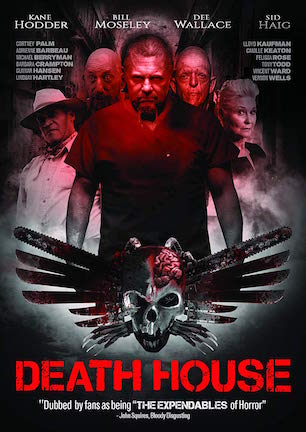Studio: Cleopatra Entertainment
Director: B. Harrison Smith
Writer: B. Harrison Smith, Gunnar Hansen
Producer: Rick Finkelstein, Steven Chase
Stars: Cody Longo, Cortney Palm, Adrienne Barbeau, Michael Berryman, Barbara Crampton, Sid Haig, Kane Hodder, Lloyd Kaufman, Bill Moseley, Tony Todd, Dee Wallace
Review Score:
Summary:
A power failure forces researchers and special agents to fight their way out of a futuristic prison housing the world’s worst killers.
Review:
Usually when someone dubs something “the worst movie I’ve ever seen,” you can amusedly roll both eyes under an assumption s/he is exaggerating. If someone were to say that about “Death House” however, I wouldn’t necessarily be quick to categorize the claim as hyperbole. Way too much trash exists out there for “Death House” to legitimately rank as “the worst horror movie of all-time.” But it’s at least in the running for “worst horror movie of the year.”
Following the film’s lazy lead, I frankly don’t feel like expending much effort on a formal critique. “Death House” is simply awful. Any shill who asserts differently is straight up full of sh*t.
Manufactured marketing desperately desires to push “Death House” as ‘The Expendables of Horror.’ While I did find two other films that made the exact same claim prior to “Death House” (“Smothered” and “William Froste”), I couldn’t dig up a source that verified this tagline as being birthed by anybody other than the filmmakers.
Not that I blame producers for trying. When the entirety of the budget was obviously blown pointlessly procuring a roster of 80s horror stars who, if we’re being brutally honest, are now known for convention appearances and diminishing credibility with cameos in DTV drivel like this, I’d tout it too. After all, “Death House” has nothing else of note to offer.
Vacant acting. Insultingly outdated effects. A nonsensically silly storyline. There’s really no benefit to detailing this monstrous mess any further. Everything about “Death House” absolutely embarrasses everyone whose name appears in its orbit.
Although the main focus stays on the exhaustive list of horror’s who’s who appearing in the film, perhaps some conjectured insight can be gleaned from the names no longer tied to the project. A 2015 report on preproduction, which teased a drastically different plot and character roster, tied Robert Englund, Doug Bradley, and Ken Foree to the title. Apparently their management had better moves for backing out than Kane Hodder, Dee Wallace, and Barbara Crampton, who bear the brunt of career bruising by being the only icons with more than a mere minute of screentime.
Having to see longtime favorites drowning so deep in the gutter is like having to visit a cancer-stricken loved one dying in a soiled deathbed. It’s uncomfortable seeing them like this.
One of the more baffling “now you see him, now you don’t” faces in “Death House” has to be Danny Trejo, who briefly appears in the movie, but conspicuously doesn’t appear in the credits. Trejo isn’t exactly selective about his work. As an actor who does indies by the hour, if you can meet his rate, he’ll show up for virtually any one-and-done scene. Assuming it isn’t an oversight (although “Death House” isn’t shy about shouting everyone else’s credit), for Trejo to not have his name placed prominently, or at all, really says something.
“Death House” started as a story from late ‘Leatherface’ actor and author Gunnar Hansen. Hansen was known for academic endeavors, having taught college courses in addition to writing nonfiction histories of America’s Barrier Islands and Maine’s Mount Desert. I’m guessing Hansen’s mind is responsible for “Death House’s” cursory parallels to ‘Dante’s Inferno’ and Nietzsche-influenced philosophies. I’m guessing a lesser mind corrupted Hansen’s ideological framework into a muddled lump of blather about software being dogma in a technological religion or something. Hansen definitely didn’t write Kane Hodder’s character threatening a woman with, “I will f*ck you in Hell.”
Maybe “Death House” would have fared better under different circumstances. Maybe an accomplished director would have pulled an actual performance out of one of the visibly disinterested genre vets (Dee Wallace barely masks annoyed contempt as she counts the seconds before she can continue chewing out her agent). Maybe a capable cinematographer would have lit the warehouse set so viewers could actually see the action, or suggested not staging 70% of scenes in front of a green screen with poorly rendered CGI backdrops. And maybe a responsible producer would have stopped cutting checks for horror celebs to stand still in the background for novelty value and apply that cash in a narratively beneficial manner instead.
Or maybe its inept fiction, which includes bizarre Tony Todd bookends that feel pulled from a totally different movie, and clumsy camerawork, which often looks like it was shot on a first-generation iPhone, doomed “Death House” from the start. All I know for certain is that 85-minute movies rarely feel like this much of an interminable slog.
NOTE: There is a mid-credits scene.
Review Score: 20






It assumes everyone watching must be a dimwit too dense to understand how the most basic storytelling concepts work.